A taper is what defines a
rod's action. Action is the way in which a rod flexes during casting.
By modifying the diameter of a rod throughout its length,
one can make rods with massively varying degrees of actions.
Tapers are designed in many ways. Trial and error are always
the final factors in determining whether a rod is 'good' or
not, but there are other ways of creating and modifying
tapers.
Everett Garrison, being an engineer, created a way to look
at bamboo rod tapers by graphing the static stress at each point
along a rod's length. The stress values of a rod are
computed by taking many variables into account including the
weight of the bamboo, finish, guides, ferrules, etc. plus
the diameter of the rod along points along its length. From
the resulting stress curve charts, it is fairly easy to
visualize the action of a rod using strictly the taper
measurements.
Stress curve charts, or simply stress curves, are graphed as
follows. A rod's tip is represented on the left side of the
graph along the X axis, and the butt section is on the
right. The Y axis contains the computed stress along each
point of the rod. Basically, the higher the point, the
softer, or more flexible, it is at that point on the rod. |
| To the right is a
stress curve chart for a Powell B8.7 straight taper
- one whose diameter changes a uniform amount of
.0145" for each 5" along its length and whose tip
dimension is .070" |
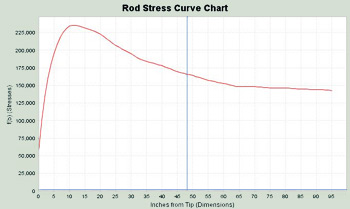 |
|
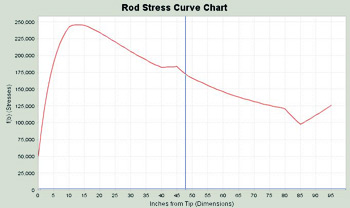 |
Compound tapers are
ones that are not straight tapers, or tapers that
get slightly wider or more thin at various points
along the length. Almost all bamboo rods are built
off of compound tapers. As an example, a fast action
rod is one that has a relatively soft tip and a
stiffer butt section, where most of the rods flex is
in the uppermost section(s) of the rod. A faster
action bamboo rod stress curve chart will often look
something like the graph for a Dickerson 8013 to the
left. |
|
| A 'parabolic' rod is
one that has a stiffer mid section pushed by a
relatively softer butt. The tip can be
anywhere from really stiff to quite soft. The
ubiquitous Paul Young Para 15 is an excellent
example of this type of action. |
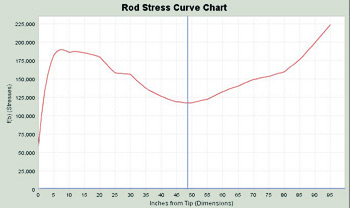 |
|
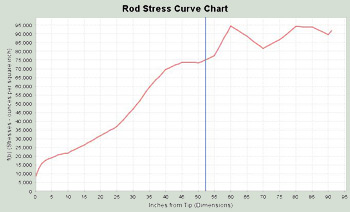 |
To the left is
another rod action that is called 'parabolic'. The
shared characteristic with the Young parabolic rod
above is obviously the relatively soft butt section
and stiffer mid. However, this Pezon et Michel Ritz
Fario taper lacks any softening in the tip section.
This basic curve shape is also seen in the few Payne
parabolic rods that exist. To me, and in keeping
with the general patterns of stress curves, this
shape would be better described as 'slow' action. |
|
| Though 'slow' is
often used as an equivalent to 'soft' the Orvis 7' 3
weight stress curve to the right is probably a
better example of a slow rod: One with a very
soft, flexible mid section that doesn't show the
characteristic soft butt of a parabolic. |
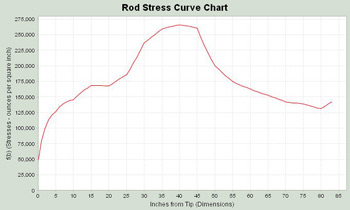 |
|
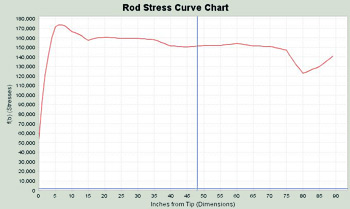 |
Garrison used his
stress curve charts to create wonderful medium, or
progressive action rods. Garrison found that tapers
with smooth, horizontal stress curves generated this
type of action, hence all of the stress curve charts
for his various rods show a very similar profile. To
the left is an example of a Garrison 209. |
|
One of the variables
that is used in computing a stress curve is the
'length of line cast' or simply casting distance. By
adding a Z axis to the standard stress curve chart,
which takes into account various distances of line
cast, one can see when a spot on a rod will become
under- or overloaded. To the right is an example of
the Dickerson 8013 from above with the addition of
the line cast from 2' to 50'.
|
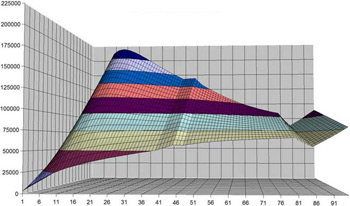 |
|
| |
|

